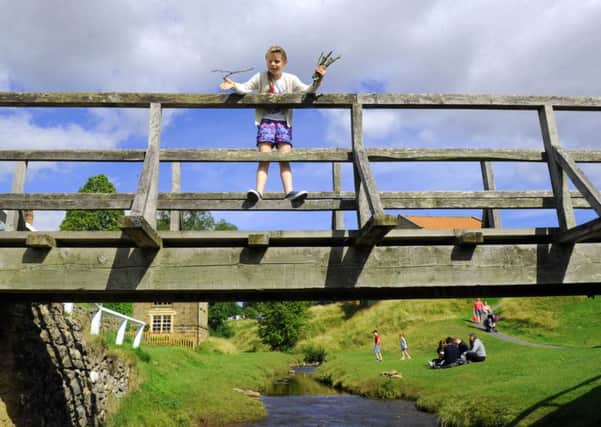Yorkshire Moors among places to follow Pooh’s footsteps


And now a leading scientist has devised a formula to boost the chances of winning Poohsticks – with a venue in North Yorkshire highlighted as one of the best in the country for the public to try their hand at the game.
Poohsticks, in which competitors drop sticks into a river upstream off a bridge and see which comes out downstream first, is first mentioned in The House At Pooh Corner by AA Milne published in 1928.
Advertisement
Hide AdAdvertisement
Hide AdAnd research commissioned to celebrate the release of The Poohsticks Handbook: A Poohstickopedia – a new book by writer Mark Evans and illustrated by Mark Burgess – reveals the secrets to finding the perfect Poohstick, as well as the names of the best places in the country to play.
Egmont Publishing joined Dr Rhys Morgan, director of engineering and education at the Royal Academy of Engineering, to equip people who already take time sourcing the perfect Poohstick with the formula to ensure they pick the speediest stick to sail to victory.
Some 57 per cent of people think Poohsticks is a game of sheer luck, but the formula disproves that view.
Meanwhile, VisitEngland has compiled the list of the best venues to play the game alongside the original Poohsticks Bridge in Ashdown Forest in East Sussex. As well as Hutton-le-Hole in the North York Moors National Park, it includes bridges from Cumbria to Cornwall, including Sheepwash Bridge, Ashford in the Water in Derbyshire, Morden Hall Park in London, Heale Gardens in Salisbury, Wiltshire, Packhorse Bridge in Watendlath, Cumbria, and Mottisfont in Romsey, Hampshire.
Advertisement
Hide AdAdvertisement
Hide AdRebecca Lowe, the head of PR at VisitEngland, said: “Poohsticks is a timeless game.
“From its first mention in AA Milne’s 1928 classic, The House At Pooh Corner, to today, it remains a great way for families to spend time together and enjoy England’s great outdoors just like Pooh.”
In his research, Dr Morgan, a father-of-two and avid Poohsticks player himself, said the main variables that need to be considered when designing the optimum Poohstick include cross sectional area, density/buoyancy, and the drag coefficient.
The perfect Poohstick is tubby and long, fairly heavy – but not so heavy it will sink to the bottom of the river – and with quite a lot of bark to catch the flow of the river like paddles.
Advertisement
Hide AdAdvertisement
Hide AdIf more water is able to influence the trajectory of the stick, it will accelerate more quickly. So when it comes to Poohsticks the tubbier, the better.
According to Dr Morgan, the fastest part of the stream is below the surface, so theoretically, a waterlogged stick which sinks into the water a little will go faster than a stick which is floating right on the surface.
And the drag coefficient describes the shape of stick and roughness of its surface.
A rough stick will normally create more drag than a smooth stick, so in general, bark is good.
Advertisement
Hide AdAdvertisement
Hide AdBut, according to Dr Morgan, a certain roughness can make the stick apparently smoother, similar to the effect created by dimples in golf balls.
The research will prove helpful for regular players of Poohsticks, as a survey of 2,000 British parents revealed that 41 per cent of players take the time to personalise their sticks to ensure they take no chances in knowing exactly who wins.